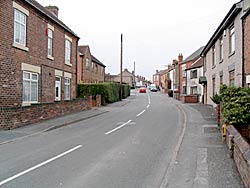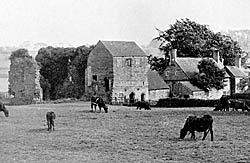Newthorpe

Main Street, Newthorpe (photo: A Nicholson, 2005).
ONE of the results of the Danish conquest of Mercia in the latter part of the 9th century, and of the permanent settlement of the Danes in England, was the development of existing Saxon villages and the further advance of agriculture.
Additional clearings were made for these purposes in forests and wastes, and in the course of this progress new hamlets termed bys or thorpes emerged. Among them was Newthorpe, which was founded as a berewick of Kimberley, amid the wastes of the extensive parish of Greasley.
Sir Frank Stenton defines the normal berewick as an outlying member of a larger estate with holdings dependent in one way or another upon the head manor, and states that a "by" was usually the equivalent for a village whereas a "thorpe" was likely to be a smaller settlement. It may, therefore, be presumed that the original form of this now busy colliery village, was little, if any more, than a farm or two, and the forepart of its name clearly relates it origin to the later part of Danish sway.
Norman days
It is first heard of by name in the Domesday survey which states that in 1086 it was of small value, mostly waste, with a wood a mile long and more than a quarter of a mile broad into which the scanty population drove their pigs for pannage. Under the Confessor, Eluin and Grinchel—apparently a Saxon and a Dane—were owners of the soil which yielded only 7s. to the geld-tax, and which within 20 years had dwindled to 3s. in taxable value while Kimberley retained its pre-Norman value of 10s. and had here two bovates of waste land.
The Conqueror, displacing the old proprietors, granted the larger part of "Neutorp" to William Peverel who, in his old age, gave it as part of his foundation gift to Lenton Priory.
The minor portion William bestowed upon the Count of Mortain, but it was not worth more than 12d. to the tax and the count made it appurtenant to his manor of Gotham. Thoroton tells that the Mortain holding "very anciently became merged in the Honour ot Leicester," from which it was long held with the manor of Gotham by the St. Andrew family.
Lenton Priory
Freedom from taxes, tolls and other dues to the Crown, with extensive civil and criminal rights within their newly-gotten territory were conferred upon the monks of Lenton by Henry II and King John, and anyone disturbing their therein was made liable to the then enormous line of £10.
In 1329 when the prior was summoned to prove his right to these privileges, he produced John's charter of 1199 and his powers were confirmed.
Under Henry II the widow of Robt de Whatton passed two bovates of local land to the priory, reserving to herself for life 2s. yearly out of its rent. At some early but unknown date Robt. de Newthorpe gave it part of a wood called Fulwood, and near the close of the 12th century Henry de Grey of Codnor (who presently forfeited his lands as a supporter of Prince John) conceded to it all claim to common of pasture in Fulwood, either belonging to the Castle at Codnor, or to its town of Eastwood or to any of his villeins.
The lost Fulwood
There were two Fulwoods in the county. One within the parish of Sutton-in-Ashfield yet exists, but the other has lost its identity and its site is a matter of conjecture. A former vicar of Greasley, the Baron von Hube, in his "Gresleia," expressed the view that the local Fulwood bordered on Shipley and Eastwood and probably reached close to Kimberley.
A record of the 14th century has the field-names Brokeclyf and Aldermerse, the former suggesting the prevalence of brocks (badgers) and the latter of alders beside rivulets within a marsh. Early in the reign of Henry III the prior granted some of Fulwood to the miller, Robert de Kynmarley, who undertook the erection of a fence to divide the properties. As part of the bargain Robert had to bind himself and his successors that if any loss or damage to the priory land accrued by reason of people going to or from his mill, the priory should be indemnified or the land upon which the mill stood would be shut up close.
Rector twice failed
By 1286, when the Pascayls of Eastwood and others had ceded their commonable rights in Fulwood, the priory proceeded to enclose the wood for its own uses, but the rector of Eastwood entered a claim to right of common on 150 of its acres. The [...] thereupon pleaded that Fulwood was extra-parochial being "neither burgh nor village." The parson lost his case and, being disatisfied with the verdict, demanded a second trial and was again unsuccessful, a jury accepting the prior's defence that Fulwood lay in Newthorpe and beyond the rector's bounds.
In 1316 the prior of Lenton was certified to be lord of the manor, but by then, the Cluniac monks were ceasing to receive gifts of value from Newthorpe. The Record Office preserves in its Ministers' Accounts for this period an official return of the priory's possessions here.

The remains of Beauvale Priory seen from the north-east (c.1930).
BEAUVALE PRIORY was founded in 1343, and after that date local benefactions to Lenton were few and unimportant, one of the last, in 1357, being that by Sir John de St. Andrew, who gave a rental of 8s. for a "light in the conventual church, as he should make it." Henceforth, the Carthusian monks of Beauvale were the chief recipients of monastic grants.
The founder of the new priory gave for its enrichment lands and rents here in 1347, and in 1360 the widow of Sir John de St. Andrew granted it a messuage, seven tofts, extensive lands, here with a rental of 12s. 7d., which her husband had held of the Honour of Leicester, the gift being confirmed by its head, John of Gaunt, Shakespeare's "time-honoured Lancaster."
Award against vicar too
In that year a messuage, a cottage and two bovates of land came to Hugh de Cressy for life, with remainder to Beauvale Priory, but for a pension of £7 10s. for himself, or his wife if she survived htm, he allowed the monks to take immediate possession of it, but this annual payment was quickly compounded for a lump sum. Like the monks of Lenton, those of Beauvale had occasion to defend their Newthorpe property, a vicar of Thorney asserting his right by inheritance to a rent of 6s. 6d. The dispute was referred to arbitration and the award was in Beauvale's favour.
Newthorpe developed considerably during the 14th century and ere it closed Beauvale Priory became a colliery proprietor.
In 1379 it granted a monopoly lease of its coal-workings in Newfield at Newthorpe to a company of eight men for live marks a year. The miners were not to exceed six in number and of them only two with a viewer were to work in the pit, the other three attending to surface duties.
This restriction perhaps was intended to preserve the coal supply from too rapid exhaustion, and the priory reserved the right of re-entry if the rent fell into arrear for one quarter.
John Flesshewer in 1406 conveyed to three partners his "coal-mines and lands in the town and fields of Newthorpe, "in return for a royalty of one-fifth of their output. Fifty-three years later, Lenton Priory negotiated a seven-year lease of a part of Beauvale's workings in Newfield. but their colliery was only "39 pickshafts in length and eight selions in width"; they paid £10 for the concession and were under bond to fill up the shafts and level the surface if called upon to do so upon relinquishing their interest.
Uncertainty as to property laws under the early Tudors led to rival claims and numerous lawsuits throughout England. About 1551, Sir Wm Bolles, to whom a moiety of Fulwood, late belonging to Felley Priory, had teen granted in 1538, sued Sir Wm. Hussey (grantee of Beauvale Priory and much of its possessions) for destroying his mines here and at Moorgreen. Claiming as lord of the manor, he alleged in the Court of the Star Chamber that under cover of darkness about a dozen ruffians, assumed to have been engaged by the defendant, had "cruellv and maliciously cast down divers frames of timber and in one pitte sunken by the petitioner had cutte in pieces great ropes, loomes and tooles appertaining to the said pitte, to the great losse and hindrance of your said subjecte and of the inhabitants of the hole countrey thereabouts."
The upshot is unknown, but Bolles had dabbled in many ex-monastic properties. He had leased a coal mine at Alfreton; he may have been hard pressed to meet his payments and possibly too eager in pursuing his own interests. What is clear is that the pits were not open-cast quarries, but shafts with equipment for raising coal.
